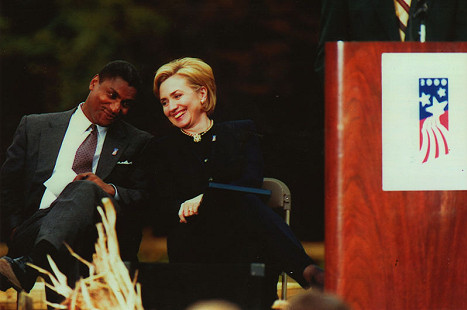HAMLET ON THE HUDSON: DESIGNATED SURVIVOR
BY NORAVEA

******
Prologue
BY NORAVEA

******
Prologue
Secretary of Housing and Urban Development Andrew Cuomo was home playing with his children in the living room of his Queens home. He was the designated survivor for President Bill Clinton's State of the Union on January 19, 1999. Clinton was in the midst of perhaps the greatest crisis his administration had faced yet, the Arkansas native facing impeachment for the first time since Andrew Johnson held the office. Like most designated survivors, Cuomo paid no attention to his duties, instead seeing it as an excuse spend time with his family that otherwise would have been spent giving multiple standing ovations to a man who himself relished in the attention that was given to him. The speech was on in the background, the forty-one year old cabinet member letting his father watch it as he spent quality time with the family.
As a man concerned with public image, his time at Housing and Urban Development was spent revamping the department's image. Ever since its inception in the 1960s, and particularly during Ronald Reagan's time in office, it was seen as a corrupt and useless government department. The image of it serving 'welfare queens' and 'thugs' or 'hoodlums' was one that dogged his work ever since taking office two years ago. Had his surname not been shared with the man in the room with him, he would have been nothing but some upstart from Queens with little to no political experience for a major cabinet position, one which under Clinton was mired with controversy. This day was like no other to Andrew Cuomo, until the world changed.
A loud 'boom' was heard on the television as the House Chamber shook, and within seconds it went to static. Within fifteen seconds according to reports, the few Secret Service agents assigned to the designated survivor rushed into his living room and grabbed him by the arms, escorting him to a car waiting outside to lead him to a designated location. It was later found out to be the 104th Precinct of the New York City Police Department. According to one young officer at the precinct that night, "everything was in complete chaos. Images of fire and smoke rising from the Capitol filled our screens, reporters and anchors completely shocked by what they witnessed. We knew at the time that Andrew Cuomo was the designated survivor, according to someone on CNN, and when we saw him being rushed into our basement, we knew that the worst had happened." With his father and family in tow, he was briefed. An airplane had crashed into the Capitol Building, an apparent terrorist attack, and two others were missing. Even though it was not confirmed, they were certain that every member in the line of succession above Cuomo was dead.
New York City Police Sergeant Taciano Arroyo was at the precinct at the time. He was filming the birthday party of one of his fellow officers at the time. "We knew something happened when the Secret Service came into the precinct with a young man being dragged with them. The man immediately behind him we all recognized as former Governor Mario Cuomo," Arroyo later said during an interview. "Well...One of the agents spotted me and asked me to follow him. I didn't know why, but I knew if I didn't my superiors would have been angry with me." Arroyo spent only ten minutes in the basement of the precinct as agents every few seconds reported new information on dead cabinet members. After a few minutes, it was confirmed. President Bill Clinton, Vice President Al Gore, the new Speaker of the House Dennis Hastert, as well as most members of Congress were confirmed killed. A second aircraft crashed into the Empire State Building, while a third crashed into the Statue of Liberty. Officers across the city were immediately called into service as the terrorist attacks sent the nation into peril.
Officer Arroyo was then asked to turn on his video camera. What few officers remained at the precinct, along with the Secret Service and Andrew Cuomo's family, surrounded the young man that was to be President. His father, Mario Cuomo, was handed a Bible and administered the oath of office. It was solemn, a moment between a father who at one time was all but guaranteed the White House, and a son, who just starting his ambitious career was thrust into the highest office in the land. As the oath was completed, a tear rolled down President Andrew Cuomo's cheek as he looked around to all of those in the room. What was earlier in the night meant to be a time to relax with family now turned into the greatest catastrophe to befall the United States of America. With a terrorist attack decapitating the head of the nation, a young man now serving as the most important person in the land, an election in less than two years, and most, if not all of the government's infrastructure now eradicated, it seemed hopeless for the nation. Wiping away the tear, Cuomo simply stood up straight as his father pat him on the back. "Let's find out who did this," the new 43rd President of the United States told everyone. "Then let's show them what happens when they attack us."
Last edited:
